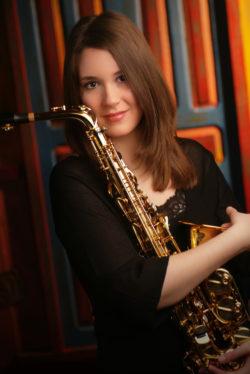
By Dr. Anna Marie Wytko
The embouchure, a word that translates from the French language as “mouth,” serves
several purposes. The most basic purpose of the embouchure is to form an airtight seal around the mouthpiece, thus allowing the air column to effectively vibrate the reed.
There are as many embouchures as there are players, because no two people present the same physiological features and characteristics. For this reason it can be misleading to present photos of the so-called correct embouchure. A person with a particular facial structure will present an embouchure that will look different, sometimes dramatically so, than that of another person with a contrary facial structure. Both embouchures may be correct.
There are, however, guidelines that can be summarized with regard to forming an effective saxophone embouchure. These guidelines are as follows:
- The lower lip should be slightly curled (formed) over the lower teeth and drawn towards the center of the mouth (versus stretched tightly). This will provide a flexible cushion for the reed. Should too much lower lip be crled over the lower teeth the reed can be overly dampened, thus producing a muted tone.
- The top teeth should be placed directly on the mouthpiece. Assuming the neck strap is adjusted properly, the teeth and natural head weight should stabilize the saxophone. Once the ideal place on the top of the mouthpiece is located, the teeth should not slide to and fro or side to side. This top teeth-mouthpiece connection should be a secure, comfortable anchor spot between the player and the instrument.
- The upper teeth and the lower teeth should be in approximate alignment (moving the lower jaw in such a manner as to purposely achieve an overbite or underbite should be avoided). It should be noted that some facial structures present a natural underbite or overbite – in these cases students are reminded that it is the lower lip’s point of contact with the reed that is most important.
- With the teeth aligned, the mouthpiece should be inserted far enough into the mouth to allow the proper amount of what may be termed “free vibrating reed” to
be set in motion by the moving air. Of course, the lower jaw is designed in a flexible, hinged manner, and can be adjusted to and fro in order to achieve approximate alignment of the upper and lower teeth. It is the placement of the lower lip in relation to the reed that is most significant, versus the place where the upper teeth make contact with the mouthpiece. The lower lip should contact the reed at approximately the point where the reed and mouthpiece separate. This point may be visually noted by carefully inserting a relatively thin piece of paper between the mouthpiece and reed; the place where the paper meets resistance is the place where the lower lip should make contact with the reed. It is possible to draw a pencil line on the reed at this point, which may serve as a visual guide. Should too little free vibrating reed be used, the tone will sound muted, dull, and excessively soft. Should too much free vibrating reed be used, the tone will sound uncontrollably loud and bright (too many high partials). - The chin should remain in a relatively relaxed, normal position.
- The corners of the mouth should be pulled toward the center. This approach may be simulated by the shape of the lips in a manner similar to whistling.
- Finally, the embouchure should be controlled but not tense. It must be flexible for a variety of reasons.
Ultimately it is the embouchure that must serve as a vehicle to allow the player to reproduce the tonal concept “heard” in the mind’s “ear” prior to producing a tone. The embouchure does not produce the tone; the player produces the tone and the embouchure allows this process to occur and is a critical tool with regards to transforming tone quality per the goal of the player.
Since this view presumes that a tonal concept must be in place before blowing the saxophone, the notion of modeling level-appropriate tones prior to asking students to “make a sound” on the saxophone is paramount. This modeling for rank beginners can be successfully accomplished in a matter of seconds or minutes, and should be repeated from time to time during the course of instruction.
Dr. Anna Marie Wytko is Assistant Professor of Saxophone in the Kansas State University School of Music, Theatre and Dance. A Yamaha Performing Artist-Clinician, Dr. Wytko has performed and taught throughout the United States and in Costa Rica, Belgium, Germany, France, Poland, England, Scotland, Canada and Mexico. Dr. Wytko’s new pedagogy book titled “The Saxophonist As Rank Beginner And Beyond: A Guide for Saxophone Methods Class, Band Directors and Private Instructors, is available through RJ Upmarket Press (www.rjupmarketpress.com) and her solo CD titled “When night came…” is available through CD Baby, iTunes and her website. www.AnnaMarieWytko.com























